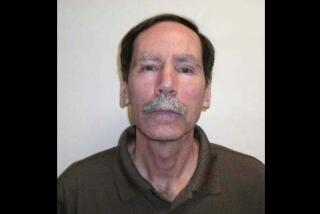Serial rapist may no longer live in proposed Antelope Valley home
A proposal to release a serial rapist to a home in the Antelope Valley has been thrown into doubt after the landlord withdrew his support for the move, the Los Angeles County district attorney’s office said Friday.
News of the landlord’s decision comes a week after a state contractor announced in court that a home had been found in the unincorporated area of Lake Los Angeles where Christopher Hubbart could live.
The choice of the home sparked complaints from local government officials and residents.
Santa Clara County Superior Court Judge Gilbert Brown had set a hearing for Dec. 4 to hear public comments about the proposed site. Brown could have ordered Hubbart’s release at the hearing.
The L.A. County district attorney’s office was thwarted in its attempts earlier this year to have Hubbart, 62, released in Santa Clara County, where he committed his most recent crimes.
Hubbart, who has spent nearly two decades in a state mental hospital, admitted sexually assaulting more than three dozen women throughout California between 1971 and 1982, according to the L.A. County district attorney’s office.
Hubbart’s attorney, Santa Clara County Deputy Public Defender Jeff Dunn, has said that Hubbart embraced intensive treatment for years while locked up in a state mental hospital and is not a public safety risk. He said Hubbart’s request for release was supported by his treating psychologist at Coalinga State Hospital and the hospital’s medical director.
Hubbart is among more than 500 offenders in California who have been confined under a law that allows authorities to commit sexually violent predators to state hospitals if they are deemed to have mental disorders that make them likely to re-offend, even if — like Hubbart — they have already served their entire prison sentences. He was one of the first to be committed when the law took effect in 1996.
Hubbart was first arrested in 1972 on suspicion of a string of rapes in Los Angeles and San Bernardino counties and admitted raping about 20 women in the area, according to court records.
He was released from a state hospital in 1979, when state doctors determined that he no longer posed a threat, a federal appeals court said. After moving to the Bay Area, Hubbart committed more sexual assaults during the next two years, according to Los Angeles County prosecutors.
In 1996, at the request of the Santa Clara County district attorney’s office, Hubbart was declared a “sexually violent predator” and committed to a state hospital for treatment. Rather than attempting a “cure,” the treatment focuses on helping patients identify what led them to commit sexual violence and develop and practice responses to reduce the chance of reoffending, according to the California Department of State Hospitals.
In May, Brown ruled that Hubbart should be freed under tight supervision in Los Angeles County, where he up and where he lived briefly the last time he was released from prison in 1993.
Once Hubbart is conditionally freed, he will have to wear an electronic monitoring ankle bracelet, report his movements and submit regularly to a polygraph and other tests.
ALSO:
Live: LAX shooting: At least 3 shot; gunman in custody
Man arrested after allegedly bringing chain saw to bar fight
Woman dies after jumping or being pushed from truck, police say
Twitter: @jackfleonard
More to Read
Sign up for Essential California
The most important California stories and recommendations in your inbox every morning.
You may occasionally receive promotional content from the Los Angeles Times.











